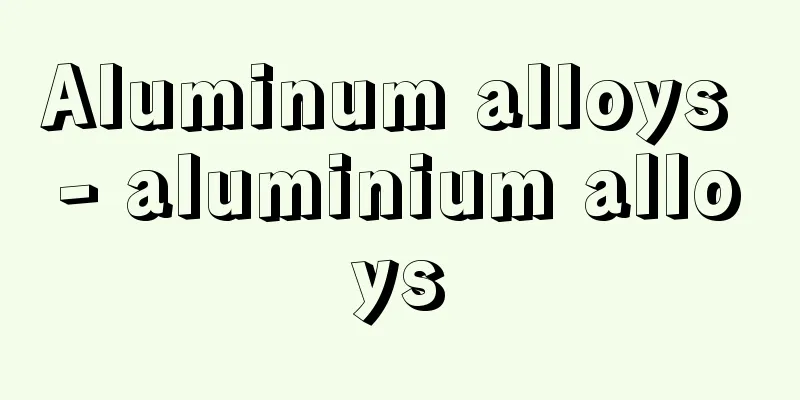Aluminum alloys - aluminium alloys

|
An alloy mainly made of aluminum with other elements added in deliberate amounts. It is also called aluminum alloy for short. Aluminum alloys are extremely light, with a density (approximately 2.7g/cm 3 ) less than half that of steel (approximately 7.8g/cm 3 ) or copper alloys (approximately 8.9g/cm 3 ). In addition, aluminum alloys are not particularly stronger than steel when compared in terms of strength per unit cross-sectional area, but when compared in terms of strength per unit mass, the specific strength (ratio of tensile strength to specific gravity) of what are called high-strength aluminum alloys is higher than that of high-tensile steel. Aluminum alloys are easy to process, and almost all metal processing methods can be applied, including cutting, extrusion, rolling, pressing, and other plastic deformation processes, casting, and welding. In addition, aluminum alloys can be relatively easily obtained in all shapes, such as plates, bars, tubes, and castings. In addition, the appearance of aluminum alloys remains unchanged in normal environments. Although aluminum itself is an active metal, its surface is covered with a thin, strong oxide film, so it does not rust or corrode and maintains its beauty for a long time. It is also a good reflector of light and radio waves, and its surface properties do not change for a long time. It is also easy to strengthen the surface by chemical treatment and improve its corrosion resistance and wear resistance. Aluminum alloys are light and strong, so when compared per unit of strength or mass, they have extremely good conductivity (thermal and electrical conductivity is about half that of copper and 3 to 4 times that of steel). Other characteristics include being non-toxic, not magnetizing, and not becoming brittle even at low temperatures. [Hiroshi Oikawa] Machinable Aluminum AlloysApproximately 80% of practical aluminum alloys are formed into the desired shape by forging, extrusion, rolling, etc. The properties are adjusted by adjusting the iron and silicon, which are the main impurities in industrial aluminum (99.5-99.99% purity). Although it has low strength, it has excellent workability, so it is used in large quantities in fields where only surface properties are an issue. High-strength alloys developed to improve strength include aluminum-copper (-magnesium) alloys (a representative example is duralumin) and aluminum-zinc-magnesium alloys (a representative example is extra-super duralumin). These are age-hardened alloys whose strength is increased by heat treatment. Corrosion-resistant alloys developed mainly to improve corrosion resistance include aluminum-manganese alloys and aluminum-magnesium alloys (a representative example is hydronalium), which achieve strength through work hardening. Between these, there are aluminum-magnesium-silicon alloys that aim for both strength and corrosion resistance, and are used for window frames and sashes. The melting point of aluminum is much lower than those of copper or iron, so it does not have much heat resistance, but there are aluminum alloys that have long had nickel added to them to improve their heat resistance, and more recently there have been dispersion strengthened alloys (a typical example is SAP) that contain very fine particles of alumina (aluminum oxide) or thorium oxide. [Hiroshi Oikawa] Aluminum alloys for castingApproximately 20% of aluminum alloys are used for castings. The castability of aluminum alloys is significantly improved by adding a large amount of silicon to make them eutectic alloys, so aluminum-silicon alloys (a typical example is silumin) are widely used when special strength is not required (non-heat-treatable alloys). The strength of alloys containing copper or magnesium can be improved by heat treatment (age hardening), so when strength is an issue, aluminum-copper-silicon alloys (a typical example is lautal) or alloys with nickel added to these to improve heat resistance (typical examples are Y alloy and RR alloy) are used, but their corrosion resistance is poor. When corrosion resistance is an issue, aluminum-magnesium alloys are used. [Hiroshi Oikawa] [Reference item] |Source: Shogakukan Encyclopedia Nipponica About Encyclopedia Nipponica Information | Legend |
|
アルミニウムを主体とし、これに他元素を意図した配合量を加えた合金。略してアルミ合金ともいう。アルミニウム合金は、その密度(約2.7g/cm3)が鉄鋼(約7.8g/cm3)や銅合金(約8.9g/cm3)の半分以下で、きわめて軽い。また、一定断面積当りの強さで比較すればとくに鋼より強いわけではないが、同じ質量当りの強さで比較すると、高力アルミニウム合金とよばれるものの比強度(引っ張り強さと比重の比)は高張力鋼よりも高い。 アルミニウム合金は加工しやすく、切削加工、押出し、圧延、プレスなどの塑性変形加工、鋳造、溶接などほとんどすべての金属加工法が適用できる。また、板、棒、管、鋳物などあらゆる形の素材が比較的簡単に得られる。また、アルミニウム合金は普通環境で外観不変である。アルミニウム自体は活性な金属であるが、その表面は薄い強固な酸化膜で覆われてしまうので、さびや腐食を生じないで美しさを長期間保つ。さらに光や電波のよい反射体で、その表面性質は長期間変わらない。また化学処理によって表面を強化し、耐食性や耐摩耗性を向上させることも容易である。アルミニウム合金は軽くて強いから、同じ強さ当り、あるいは同じ質量当りで比較すると、きわめて優れた伝導性をもつことになる(熱や電気の伝導率は銅の約2分の1、鋼の3~4倍)。そのほか、無毒であること、磁化しないこと、低温になってももろくならないことなどの特徴がある。 [及川 洪] 加工用アルミニウム合金実用アルミニウム合金の約80%は鍛造、押出し、圧延などで所望の形に成形して用いる。工業用アルミニウム(純度99.5~99.99%)のおもな不純物である鉄とケイ素を加減して特性を調節する。強さは低いが加工性に優れているので、表面特性のみが問題となる分野で多量に用いられている。強さを向上させることを目的に開発された高力合金系としてアルミニウム‐銅(‐マグネシウム)系合金(代表例ジュラルミン)、アルミニウム‐亜鉛‐マグネシウム系合金(代表例超々ジュラルミン)などがある。これらは熱処理によって強さを高める時効硬化型合金である。また主として耐食性をも向上させることを目的として開発された耐食合金系としてアルミニウム‐マンガン系合金、アルミニウム‐マグネシウム系合金(代表例ヒドロナリウム)などがあり、これは加工硬化で強さを出す。この中間として強さ、耐食の双方をねらったアルミニウム‐マグネシウム‐ケイ素系合金があり、窓枠サッシなどに使われる。アルミニウムの融点は銅や鉄に比べるとかなり低いので耐熱性はあまりないが、アルミニウム合金として耐熱性を向上させた合金としては、昔からニッケルを加えた合金があり、最近は非常に細かいアルミナ(酸化アルミニウム)やトリア(酸化トリウム)の粒子を含ませた分散強化合金(代表例SAP)もある。 [及川 洪] 鋳造用アルミニウム合金アルミニウム合金の約20%は鋳物に利用される。アルミニウム合金の鋳造性は、ケイ素を多く加えた共晶合金にすることによって著しく改良されるので、特別な強さを必要としない場合にはアルミニウム‐ケイ素系合金(代表例シルミン)が広く用いられる(非熱処理型合金)。銅やマグネシウムを含む合金は熱処理(時効硬化)によって強さを向上できるので、強さが問題となる場合にはアルミニウム‐銅‐ケイ素系合金(代表例ラウタル)や、これにニッケルを加えて耐熱性を向上させた合金(代表例Y合金、RR合金)などが使用されるが、耐食性はよくない。耐食性が問題となる場合にはアルミニウム‐マグネシウム系合金が使用される。 [及川 洪] [参照項目] |出典 小学館 日本大百科全書(ニッポニカ)日本大百科全書(ニッポニカ)について 情報 | 凡例 |
>>: Aluminum - aluminium (English spelling)
Recommend
Fechner, E.
…Today, Arthur Kaufmann (1923- ) is a representat...
Wireworm
…They have thoracic legs, and some have a pair of...
Coronel (English spelling)
A port city in south-central Chile. It is located ...
troop
...Several bands may gather near nighttime shelte...
Podiceps cristatus (English)
…[Hiroshi Hasegawa]. … *Some of the terminology t...
Lateran Agreement - Lateran Treaty
Two agreements signed in 1929 between the Italian ...
Succession - Shuumei
In classical performing arts or professions requi...
Kankata
A general term for instrumentalists in gagaku, esp...
Adobe
Also known as sun-dried bricks, adobe is a type of...
Méryon, Charles
Born: November 23, 1821 in Paris [Died] February 1...
Springbok - Springbok (English spelling)
It is an animal of the order Artiodactyla, family...
Hard fabric - Hard discharge
〘 noun 〙 Tightly woven fabric. Twill. ※Matsusake S...
The Three Calligraphy Works of the Kan'ei Era
…In 1601, he returned to his post as Minister of ...
Type theory - type theory
A concept proposed and introduced by Bertrand AW R...
ILO Convention No. 89 - ILO Convention No. 89
…(See the sections on Child Labor and Minor Labor...









